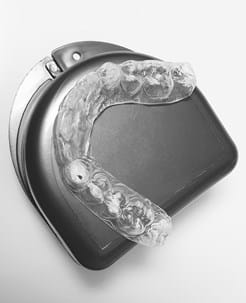Bruxism
Bruxism is the involuntary grinding or clenching of teeth, often occurring during sleep. It can lead to tooth wear, jaw pain, headaches, and other dental issues. Common causes include stress, misaligned teeth, and sleep disorders.
Bruxism can cause a range of symptoms, including jaw pain, headaches, tooth sensitivity, worn or chipped teeth, cracked teeth, crowns or fillings, loose teeth. Many people grind their teeth at night without realising it, but signs like tight jaw muscles, facial soreness, and sleep disturbances may indicate a problem. Some may also experience ear pain or clicking sounds in the jaw.
Bruxism is usually hand-in-hand with Temporomandibular Disorder (TMD), a condition that affects the jaw joint, or the TMJ. TMD may be causing your jaw pain, clicking or popping sounds, difficulty chewing, headaches, and even jaw locking. TMD can result from factors like bruxism, stress, misaligned teeth, or jaw injury.
Our dentists are skilled in assessing and managing TMD and bruxism.

Treatment for TMD and Bruxism
At Carlton Dental, we successfully treat and manage TMD and bruxism for our patients with occlusal splints and muscle relaxant injections (like Botox®). These treatment modalities protect your teeth, crowns, implants from wear and cracking, and help relieve muscle tension and painful joint symptoms.
Ignoring TMD and bruxism can lead to chronic jaw pain, tooth damage, headaches, and even difficulty eating or speaking. Untreated bruxism can wear down teeth, increasing the risk of fractures and sensitivity, while TMD can cause long-term joint problems and discomfort. Early treatment helps protect your teeth, relieve pain, and prevent further complications.
If you’re experiencing symptoms, don’t wait, because as always, prevention is the key.
Contact the Experts in TMD Symptoms and Treatment
Although this is not an exhaustive list, toothache, earache, headache, dizziness and ringing in the ears are among some of the other symptoms.
If you are experiencing any of these, please contact us.
The dentists at Carlton Dental, highly competent in the fine work skills of gnathology and meticulous dentistry, are ready to provide you with compassionate care; relieving your TMD symptoms and your pain, often without need for the typically prescribed night splints or the often misdiagnosed need for endodontic therapy.

